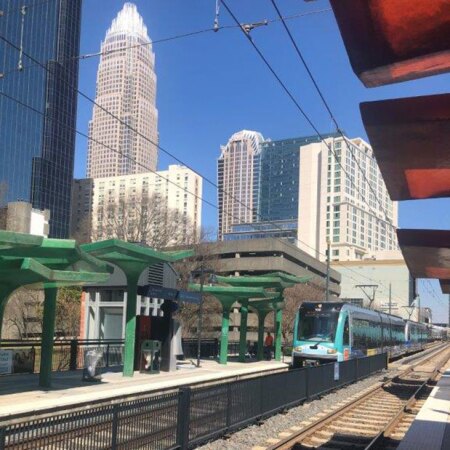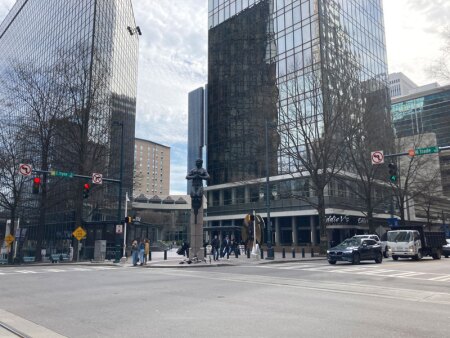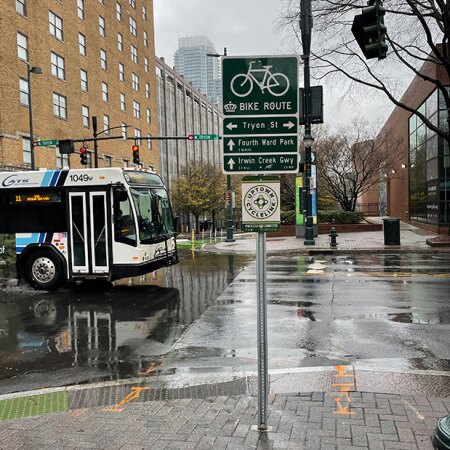In an age of climate change, transit is a strategic investment for stronger and more livable communities. Charlotte, North Carolina, has pursued a steady vision for regional transit service, marked by local voters’ commitment to a transit-dedicated sales tax since 1998 which led to the 2007 opening of the LYNX Blue Line light rail service.
The most recent proposed addition to the transit network, the LYNX Silver Line, will connect the region along 29 miles in Charlotte’s Southeast corridor. The Silver Line was also the beneficiary in 2022 of a $405,000 Transit Oriented Development Planning Grant from the Federal Transit Administration, designed to help communities integrate land use and transportation planning.
Charlotte is one of the 20 largest cities in the U.S. and the largest city in North Carolina, with more than 870,000 residents. The Charlotte Area Transit System (CATS) is a department of the City of Charlotte and is governed by the Metropolitan Transit Commission. The CATS service area is a population of 1.3 million. CATS is the largest transit system between Washington, D.C., and Atlanta, offering bus, light rail, streetcar, vanpool, and Special Transportation Services.
The Future of the LYNX Silver Line
In partnership with the City of Charlotte Planning, Design, & Development Department, CATS sought a ULI Advisory Services panel in 2022 to advise on how plans for a Silver Line light rail in the next stage of LYNX transit development could help the city thrive and continue to grow sustainably—specifically, to analyze the proposed Uptown alignment and evaluate potential opportunities in the surrounding Center City-based study area. The study area centered on 1.7 square miles of Uptown and approximately a ¼ mile radius from the planned station locations at 11th Street.
The panel was chaired by Marilee Utter, president, Citiventure, in Denver. Panelists included Dr. David Abraham, assistant director, strategic planning at the Harris County Toll Road Authority and planning, policy and transportation professor at Rice University in Houston ; Guillermo Aguilar, principal at Aguilar Architects in Dana Point, California; Christopher Forinash, principal at Nelson/Nygaard in Washington, D.C.; Lucia E. Garsys, senior advisor for community partnerships at the Hillsborough County Government in Tampa; Jim Hecht, transit engineering business class director at HDR in San Diego; Darryl Jones, senior vice president at Coventry Development Corporation in Lone Tree, Colorado; and Jack Wierzenski, director, economic development and planning at Dallas Area Rapid Transit in Dallas.
Exploring Potential for Transit-Oriented Development
The panel’s assignment: Explore the potential for economic and station area development along the 11th Street route. Among the key questions from the panel sponsor:
- Would an alternate Silver Line rail alignment provide better opportunities for economic development, as well as equity in mobility and transportation access?
- How could transit expansion efforts optimize equitable access and the connection between the Blue Line and Silver Line rails?
- Would an additional Silver Line station along the 11th Street route in the First Ward expand opportunities for station area development?
- How can the city bring key landholders and partners to the table to support these transit connections?
Maximizing Regional Equity and Mobility Potential along the Silver Line
The planned Silver Line alignment stretches through three counties and five jurisdictions. The panel noted that this offers a 29-mile (46.7 km) opportunity to integrate equity in the greater region, amidst major job and residential growth expected in this southeast corridor over the next 30 years. Panelists urged an emphasis on transit investments to incubate and support places that enable people to live without depending on driving.
The panel recommended linking all LYNX stations to other transit modes to achieve sustainable growth patterns and maximize the city’s infrastructure. Another panel recommendation encouraged locating transit stops along the proposed Silver Line to serve communities equitably in proportion to the race and ethnic distributions in the city and county.
Boosting Housing Options in the Central City—and Dodging Displacement
To support more sustainable development, the panel urged Charlotte to promote more transit-oriented development, particularly higher-density residential development in Center City areas.
“We found that there are only 12,550 people living in the Uptown area. This is a very low number for a major growing downtown in this state. There more parking spots than people in the downtown. 70,000 parking spots, versus 12,550 people,” observed panelist David Abraham.
Elsewhere on the Silver Line, a community needs assessment, a mixed-income housing strategy, and the creation of an investment strategy task force could help guide TOD around transit stations.
However, panelists cautioned that a climb in real estate values that accompanies new TOD opportunities poses a risk of displacement to current residents, especially renters and lower-income households. They urged the city to counter this risk with mixed-income housing around Silver Line stations. Panelists also encouraged the City of Charlotte to work with the community to design, fund, and implement a range of anti-displacement tools.
Plan and Design for the 11th Street Station
The panel suggested several options for the 11th Street Station, including exploring the feasibility of interlining the Silver Line and the Blue Line and making the 11th Street station part of a vibrant mixed-use destination that would help to attract riders. The panel encouraged the station design and operation to take place in coordination with a public/private partnership that could integrate transit services with private development on adjacent land parcels. This public/private partnership could also help unleash ample TOD opportunities within a quarter-mile walk of the current and planned stations.
Alignment Alternatives
In considering 11th Street versus other potential alignments, the panel took a practical approach, focusing on access to competitive Federal Transit Administration New Starts funding based on two key criteria: ridership and cost-effectiveness. The panel noted that a Silver Line/Blue Line interline option through Uptown would improve cost and ridership substantially for a competitive FTA rating.
Panel member Jim Hecht noted during the panel presentation, “Our recommendation is to evaluate modifications to the project to reduce cost and increase ridership.”
Positioning for a Successful Referendum
A sales tax referendum for Mecklenburg County voters will be considered to support the CATS 2030 Transit System Plan. The panel examined how to pursue a successful referendum to support transit investments once state authorization is secured. Recommendations included carefully crafting a message that reflects voter priorities, and undertaking a robust engagement program with business, civic, and community leaders.
Panelist Lucia Garsys encouraged intense and robust engagement within the community to advocate for transit support. “The more you build coalitions with all your business and civic organizations, the stronger you will be. Get everyone on board.”
Impact of the ULI Advisory Services Panel
The panel’s recommendations clearly had an impact. A few months after the panel, CATS announced a new route for the first segment of the Silver Line that would bring the train directly into Uptown as well as interline with the Blue Line, directly reflecting the panel’s recommendation.
With major job growth expected in the southeast corridor over the next 30 years, the strategic development of the Silver Line will reduce the need to build and maintain new highways, and save billions of future dollars in the economy.
Panel chair Utter said, “Transit is a hundred-year asset. It’s a long-term asset. It’s thinking about your community in a much broader way than just what’s happening today.”
Getting the Uptown Silver Line alignment and access points on the right track—while addressing the need to advance equity and mobility—will be critical to Charlotte’s future.
DEBORAH MYERSON is a housing and community development consultant based in Bloomington, Indiana. She served as the panel program manager for the ULI Charlotte Silver Line panel.





